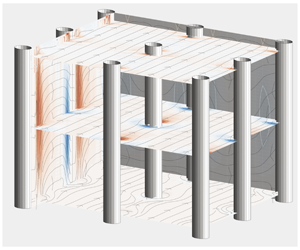Article contents
On the genesis of different regimes in canopy flows: a numerical investigation
Published online by Cambridge University Press: 20 March 2020
Abstract

We have performed fully resolved simulations of turbulent flows over various submerged rigid canopies covering the wall of an open channel. All the numerical predictions have been obtained considering the same nominal bulk Reynolds number (i.e.  $Re_{b}=U_{b}H/\unicode[STIX]{x1D708}=6000$,
$Re_{b}=U_{b}H/\unicode[STIX]{x1D708}=6000$,  $H$ being the channel depth and
$H$ being the channel depth and  $U_{b}$ the bulk velocity). The computations directly tackle the region occupied by the canopy by imposing the zero-velocity condition on every single stem, while the outer flow is dealt with a highly resolved large-eddy simulation. Four canopy configurations have been considered. All of them share the same in-plane solid fraction while the canopy to channel height ratios have been selected to be
$U_{b}$ the bulk velocity). The computations directly tackle the region occupied by the canopy by imposing the zero-velocity condition on every single stem, while the outer flow is dealt with a highly resolved large-eddy simulation. Four canopy configurations have been considered. All of them share the same in-plane solid fraction while the canopy to channel height ratios have been selected to be  $h/H=(0.05,0.1,0.25,0.4)$. The lowest and the highest values lead to flow conditions approaching the two asymptotic states that in the literature are usually termed the sparse and dense regimes (see Nepf (Annu. Rev. Fluid Mech., vol. 44, 2012, pp. 123–142)). The other two
$h/H=(0.05,0.1,0.25,0.4)$. The lowest and the highest values lead to flow conditions approaching the two asymptotic states that in the literature are usually termed the sparse and dense regimes (see Nepf (Annu. Rev. Fluid Mech., vol. 44, 2012, pp. 123–142)). The other two  $h/H$ selected ratios are representative of transitional regimes, a generic category that incorporates all the non-asymptotic states. While the interaction of a turbulent flow with a filamentous canopy in the two asymptotic conditions is relatively well understood, not much is known on the transitional flows and on the physical mechanisms that are responsible for the variations of flow regimes when the canopy solidity is changed. The effects of the latter on the flow developing in the intra-canopy region, on the outer flow and on their mutual interactions have been numerically explored and are reported in this work. By systematically varying the canopy height, we have unravelled the main character of the different regimes that are generated by the interplay between the outer flow structures, the emerging instabilities driven by the canopy drag and the interstitial flow between the canopy stems. The key role played by the relative positions of the inflection points of the mean velocity profile and the location of the virtual wall origin (as seen from the outer flow) is put forward and used to define a new condition to infer the canopy flow regime when the solidity is changed. Finally, the presence and the effects of an instability occurring close to the bed, nearby the interior inflectional point of the mean velocity profile is highlighted together with its consequences on the flow structure within the canopy region. To the best of our knowledge, this is the first time that the emergence of close-to-the-bed coherent structures induced by the inner inflection point is reported in the literature.
$h/H$ selected ratios are representative of transitional regimes, a generic category that incorporates all the non-asymptotic states. While the interaction of a turbulent flow with a filamentous canopy in the two asymptotic conditions is relatively well understood, not much is known on the transitional flows and on the physical mechanisms that are responsible for the variations of flow regimes when the canopy solidity is changed. The effects of the latter on the flow developing in the intra-canopy region, on the outer flow and on their mutual interactions have been numerically explored and are reported in this work. By systematically varying the canopy height, we have unravelled the main character of the different regimes that are generated by the interplay between the outer flow structures, the emerging instabilities driven by the canopy drag and the interstitial flow between the canopy stems. The key role played by the relative positions of the inflection points of the mean velocity profile and the location of the virtual wall origin (as seen from the outer flow) is put forward and used to define a new condition to infer the canopy flow regime when the solidity is changed. Finally, the presence and the effects of an instability occurring close to the bed, nearby the interior inflectional point of the mean velocity profile is highlighted together with its consequences on the flow structure within the canopy region. To the best of our knowledge, this is the first time that the emergence of close-to-the-bed coherent structures induced by the inner inflection point is reported in the literature.
JFM classification
Information
- Type
- JFM Papers
- Information
- Copyright
- © The Author(s), 2020. Published by Cambridge University Press
References
- 27
- Cited by

